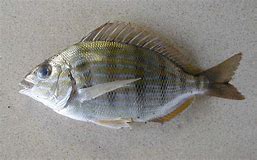When writing about wildlife you may encounter on our local beaches, you sometimes overlook the obvious… like the pinfish.

Photo: Nicholls State University
There are over 500 species of fishes found in the Gulf of Mexico, and estimated 200 of them have been found in the Pensacola Bay area. Articles about sharks, stingrays, snappers, and lionfish are common. However, we do not write much about the fish that most of us encounter every time we visit our beaches, and the pinfish would fit into that category.
It is probably the first fish local anglers ever caught… and, if fishing the bay, probably still catch more than they want. When you don a mask and snorkel to explore the grassbeds, you will see hundreds of these fish. Most of us have experienced standing in the shallow water where the bottom is sandy and feel little nips at your ankles. We more often than not scream “CRABS!” when in fact they are actually pinfish. If you have mask you can view the sandy bottom – swash the sand a bit – and several will appear looking for an uncovered meal. This is probably what happens when we are standing in the water. Our feet are moving and adjusting, stirring up sand and hungry pinfish at the same time. And then… nip – they get you again.
But who is this interesting fish we see so often but do not give a second thought?
Pinfish (Lagodon rhomboides) are members of the porgy family (Sparidae) which includes the sheepshead. This group has eight incisors in each jaw for nipping (and we know about that) off barnacles and other shellfish as well as two rows of rounded molars for crushing their shells. If you have ever cleaned the bottom of a boat with a paint scrapper – removing barnacles, and sometimes oysters, you have probably seen both of these porgies hanging around waiting for a free meal.
Pinfish are smaller than their cousin the sheepshead. Most reach a whopping size of 5” but further offshore large ones have been found. They generally have 5-6 vertical bars on their sides covered by numerous yellow stripes and a dark spot on their shoulder. However, I have collected these fish when either the stripes or the bars are not visible – I have always seen the spot. They have 12 spines in their dorsal fin from which they get their common name “pin”fish.
The smaller juveniles live in the estuaries. They are found over open sand, grassbeds, and in salt marshes. They are carnivorous at this stage eating a variety of small animals, but prefer amphipods (small shrimp-like creatures that live in the sand). Anglers know at this stage they will eat just about any bait you put on the line – and are actually pretty good at getting it off the hook without being snagged themselves. Many locals like them as live bait for larger offshore species. There pinfish traps at most bait and tackle shops, many use cast nets to collect them before they head offshore, and there is actually an industry in culturing them for bait.
When they are about four inches long – they head offshore and become herbivorous. They have been found at depths between 30-50 feet. Pinfish reach sexual maturity at this size and breed in the late fall and winter. The female releases thousands of eggs for the males to fertilize. Anywhere from 7,000 to 90,000 eggs can be fertilized during a spawning event – but 21,000 is about average.
They are extremely hardy fish, tolerating a wide range of salinities and temperatures. They are found from the Mid-Atlantic States to Bermuda and South America. They are popular in research labs because of (a) their high tolerance for environmental change, and (b) how common they are – you can collect a lot of pinfish around here.
Therefore, when you are fishing with your new young angler, or snorkeling near a rock jetty or in a grassbed, you will now have a better understanding of this very common, and often overlooked local fish… the pinfish.
References
Indian River Species Inventory. Lagodon rhomboides. Pinfish. Smithsonian Marine Station at Ft. Pierce. http://www.sms.si.edu/IRLSpec/Lagodo_rhombo.htm.
Lagodon rhomboides. Wikipedia. https://en.wikipedia.org/wiki/Lagodon_rhomboides.
Pinfish. Lagodon rhomboides. Texas Parks and Wildlife. https://tpwd.texas.gov/huntwild/wild/species/pinfish/.
 0
0
